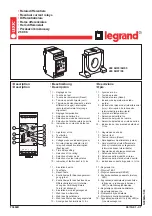
3-4
BE1-51/27R - Functional Description
Where:
M
=
Multiple of tap value current
I
=
Applied current level
I
T
=
Tap value
V
N
=
Nominal voltage, and V = applied voltage level
Microprocessor (Not shown)
Some of the circuitry already discussed is part of the microprocessor and no definite lines are drawn to
separate the functions. The microprocessor compares the desired time delay (from the time trip comparator
and scaler) with the actual elapsed time from the counter. When the elapsed time reaches the intended
delay the timed output relay is energized. During the time delay period , the front panel TIMING indicator
(i.e.: pickup) associated with the detected phase is illuminated.
If targets are present, the front panel TIME FUNCTION target will be tripped, and the A, B, C, or N ELE-
MENT target associated with the detected phase will be tripped. See table 2-4 for the types of targets that
are present (depending upon relay configuration).
If option 3 is present, an auxiliary output relay (with either N.O., N.C., or SPDT contacts) is also actuated
when the timed output relay energizes.
Instantaneous Overcurrent (Options 1-1 and 1-2)
Input current levels applied to the time overcurrent circuitry are also passed to the instantaneous overcurrent
circuitry. These levels are compared to the setting of the front panel INST 1 adjust and the front panel INST
1 (NEUTRAL) adjust (if present). If the input current level is above the setting, the output driver energizes
the instantaneous 1 Output Relay. If the instantaneous 2 option is present, the input level is also compared
with the setting of the front panel INST 2 adjust to energize the instantaneous 2 output relay. Note that the
current level settings for the instantaneous overcurrent element will always be from 1 to 40 times above the
front panel TAP and TAP (NEUTRAL) settings of the time overcurrent element.
If target type A or B is present, the front panel INST 1 target and the front panel INST 2 targets are tripped
when their respective output relay is energized, along with the front panel A, B, C, or N ELEMENT targets
(if present) associated with the detected phases. (See Section 3 for the types of targets that can be present
depending upon the relay configuration.)
Timed and Instantaneous Outputs
Each output signal (representing either time overcurrent or instantaneous overcurrent) from each monitored
phase (or neutral) is applied to the respective output driver. Each output driver supplies operating current
to energize it associated output relay. Either normally open (output type E) or normally closed (output type
G) contacts may be specified. (The contact configurations of all output relays for a given model will be the
same.)
Auxiliary Outputs
In addition to the output relays, an auxiliary relay, having the same or a different contact configuration, may
be specified. Both the output and the auxiliary relays will remain energized for the duration of the
overcurrent condition.
Push-to-Energize Pushbuttons
If either option 2-C or 2-E is present, each individual output relay can be directly energized for test purposes
by the actuation of a front panel PUSH-TO-ENERGIZE OUTPUT pushbutton. The pushbutton is actuated
by the insertion of a thin, non-conducting rod through an access hole in the front panel.
Power Supply Status Output (Option 3-6)
Power supply status output relays have a set of normally closed contacts that are energized open during
power-up. If either or both power supply output legs (+12 Vdc or -12 Vdc) fails, the power supply status
output relay is de-energized and the output contacts close. Shorting bars across the output contacts are
















































